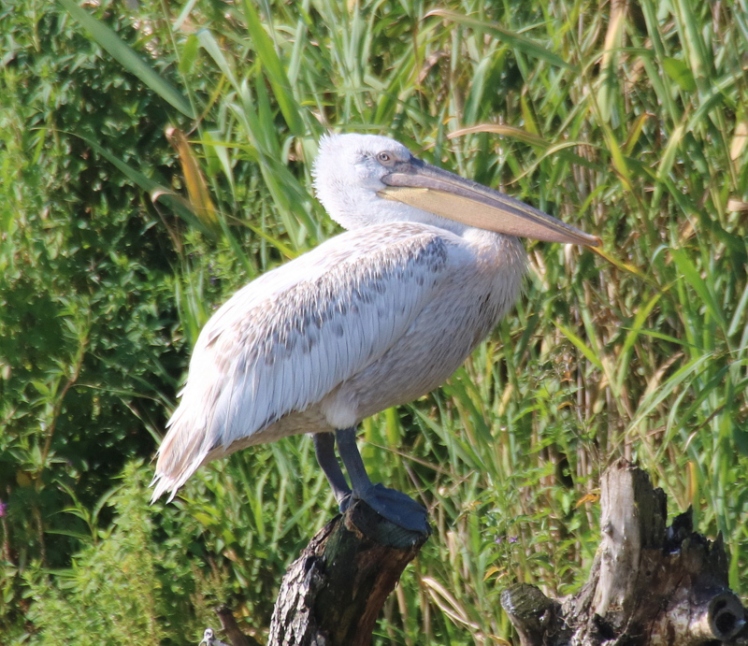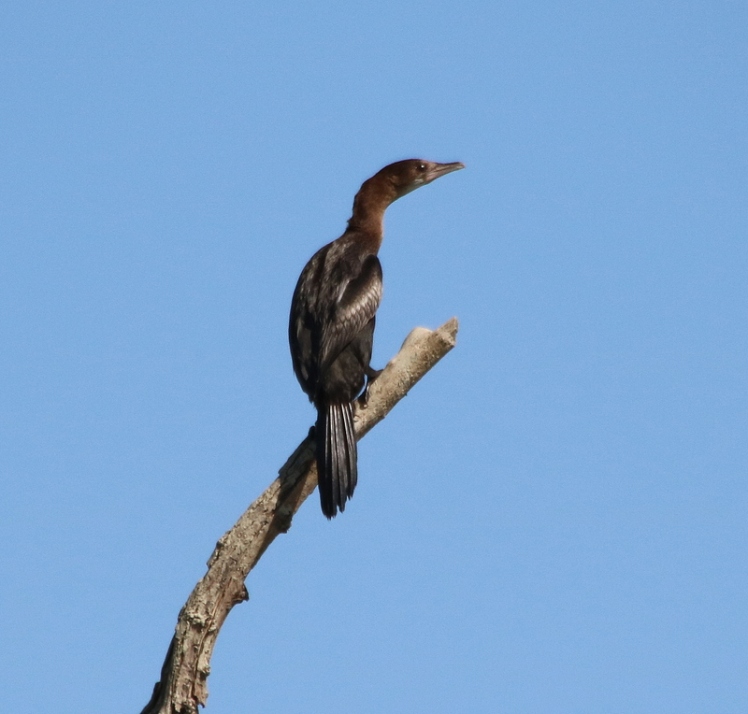Romania- Part 2
We transferred to the Danube Delta, and had a very relaxing four days of cruising the channels around the delta.
The main feature of this unique ecosystem is the waterbirds, and chief among them are the pelicans- we had hundreds of White Pelicans over the course of cruising around the channels, but we only managed to locate five individual Dalmatian Pelicans. Nevertheless, we eventually secured good views of birds on the ground. However, if you solely want to photograph pelicans, you really want to visit Lake Kerkini in Greece in February. However, this wasn’t the aim of the visit to the Delta.



Pygmy Cormorants were only seen in the Delta, and they’re quite skittish birds, being seen in ones and twos at most. Some more distant shots could be acquired but nevertheless they didn’t show especially well.

Another feature of the waterbirds were the ducks. We recorded six species- mostly Mallard, Shelduck, Garganey and Ferruginous Duck (we counted a flock of 1000 of this species on one of the lakes on the third day), but we also managed to dig up one Tufted Duck and even a flock of seven Goldeneye on the last day.

Grebes also featured- mostly Great Crested Grebes but we also unearthed three beautiful Red-necked Grebes– being from Norfolk we only ever really see them in their grey winter plumage, so to see them in their beautiful red glory was a real treat. In addition, one each of Little and Black-necked Grebes completed a very good haul.

The other main highlight of the Delta were the herons. We recorded nine species of heron over the course of four days- the commonest ones by far were Squacco, Grey and Purple Herons and Little and Great White Egrets but we also found several Night Herons, mostly juveniles but one adult showed well for us on the last day. In addition, a couple of Little Bitterns occasionally popped out of the reedbeds, and I even managed to pick up a solitary Great Bittern– not common by any stretch in the Delta. Three Spoonbills were also seen over the course of our stay, and Glossy Ibises were fairly common.




In terms of raptors, White-tailed Eagles were common and fantastic to see fishing around the various lakes and open bodies of water. Marsh Harriers were also fairly common, and a few Hobbies were picked up too. In addition, we had the extremely good fortune of seeing a Black Kite passing over the boat on our last day; a ringtail Montagu’s Harrier also put in an appearance, as well as one Red-footed Falcon, and two Honey Buzzards which we found over Letea forest.


We also recorded quite a few waders- 14 species of wader was a very good tally, but the real delight was that three species- Wood, Green and Common Sandpipers were absolutely everywhere- every third wader was one of these three species, and we would frequently flush them off the muddy banks.
Terns also put in a good showing- most of them were Whiskered Terns and it was delight to see these wisps flying around us on the lake. Common Terns were also a regular feature of the more open channels and lakes. We counted an astonishing 55 (minimum) Caspian Terns at Caraorman with others dotted around various places, and we even found an adult White-winged Black Tern which overflew our boat near Mila 23.
Passerines also comprised a surprising proportion of the highlights. We finally caught up with BLACK WOODPECKER, woodpecker species number eight for the trip, and Grey-headed, Syrian and Great and Lesser Spotted Woodpeckers were also seen.
Letea forest on the north side of the Delta near Ukraine is a highly unique habitat, a forest sat on a sandy island right in the middle of a sea of reedbeds. We managed to find at least three Collared Flycatchers in this fantastic habitat, a real stunner too. This was also where we found the two Honey Buzzards, and the whole area provided a roosting Long-eared Owl flushed out of a tree, our only Wood Warbler of the trip, one of the Black Woodpeckers.
Caraorman, in addition to the terns, waders and Great Bittern, gave good views of Penduline Tit.
One of the more productive channels at the west end is Mila 36 (so named after its distance from the river mouth, 36 miles), a thickly wooded channel with good stands of mature trees. This area yielded all five of the Delta’s woodpeckers, as well as three Thrush Nightingales, five Redstarts, and various warblers such as Willow Warbler and Chiffchaff.
We stayed in a fantastic rural guesthouse in the village of Crisan, fast being developed as a tourist village. However, there is still some fantastic habitat around the village, notably a large clump of tamarisks near the west end on the north bank, which during our stay held three different Citrine Wagtails, a stunning Bluethroat, another Thrush Nightingale, at least two Spotted Flycatchers and a Whitethroat– really not bad for mid-August! Future visitors would not be wasting time checking this fantastic habitat. Other birds added to the trip list in the Delta were Cuckoo, Bearded Tit, Little Crake, Northern Long-tailed Tit (of the white-headed race caudatus here) and Great Reed Warbler.
In conclusion, the Danube Delta is a true jewel of European birding, and I will forever cherish the unique memories of cruising along the channels in our boat picking out herons, cormorants and other bits and pieces that truly make the Delta special. This is an absolute must for any birder visiting the Delta. But heed these pieces of advice.
- The Delta cannot be done alone. A guide or boatman who knows where the birds like to get is essential for truly experiencing the magic of the Delta.
- Go in spring. The birds are a lot more active and will therefore be easier to find. In addition, you will experience the unique dawn chorus and a whole host of other events that you simply will not experience in spring.
- Go as soon as you can. The Delta is under threat from sea level rise, making the habitat more saline and unsuitable for a lot of plants, but also an unforeseen threat is plaguing the Delta: the speedboats. A lot of the time, tourist day-trip boats out of Tulcea go thundering down these narrow channels, generating a lot of swell and thus eroding the banks. This also flushes the birds away into private lakes where access is prohibited or even away from the Delta altogether, and the local guides have remarked that the sheer number of birds have visibly declined even in just 6 years. So if you still want to experience the Delta’s magic, I would go sooner rather than later.
- Be prepared to eat a lot of fish! Due to the lack of meat, you will be eating fish pretty much every day- despite this mainly being carp (stiffed royally by the language- carp is ‘crap’ in Romanian!) and catfish, it is very good and would thoroughly recommend it!
We came off on the final day refreshed and ready for our final adventure in the wilds of Eastern Europe, in the Carpathians, tune in tomorrow for an explosive finale- I can hardly bear the excitement…




